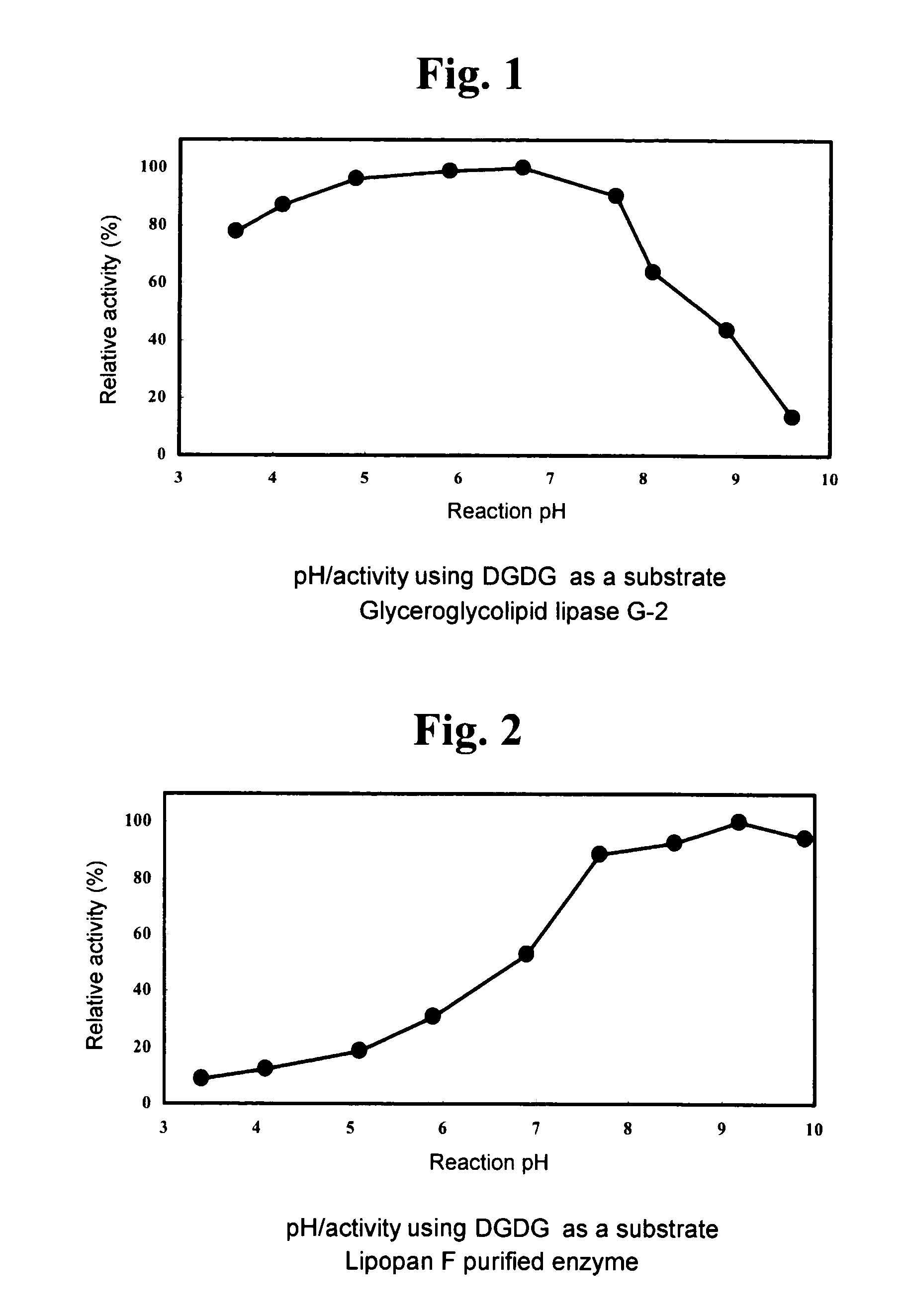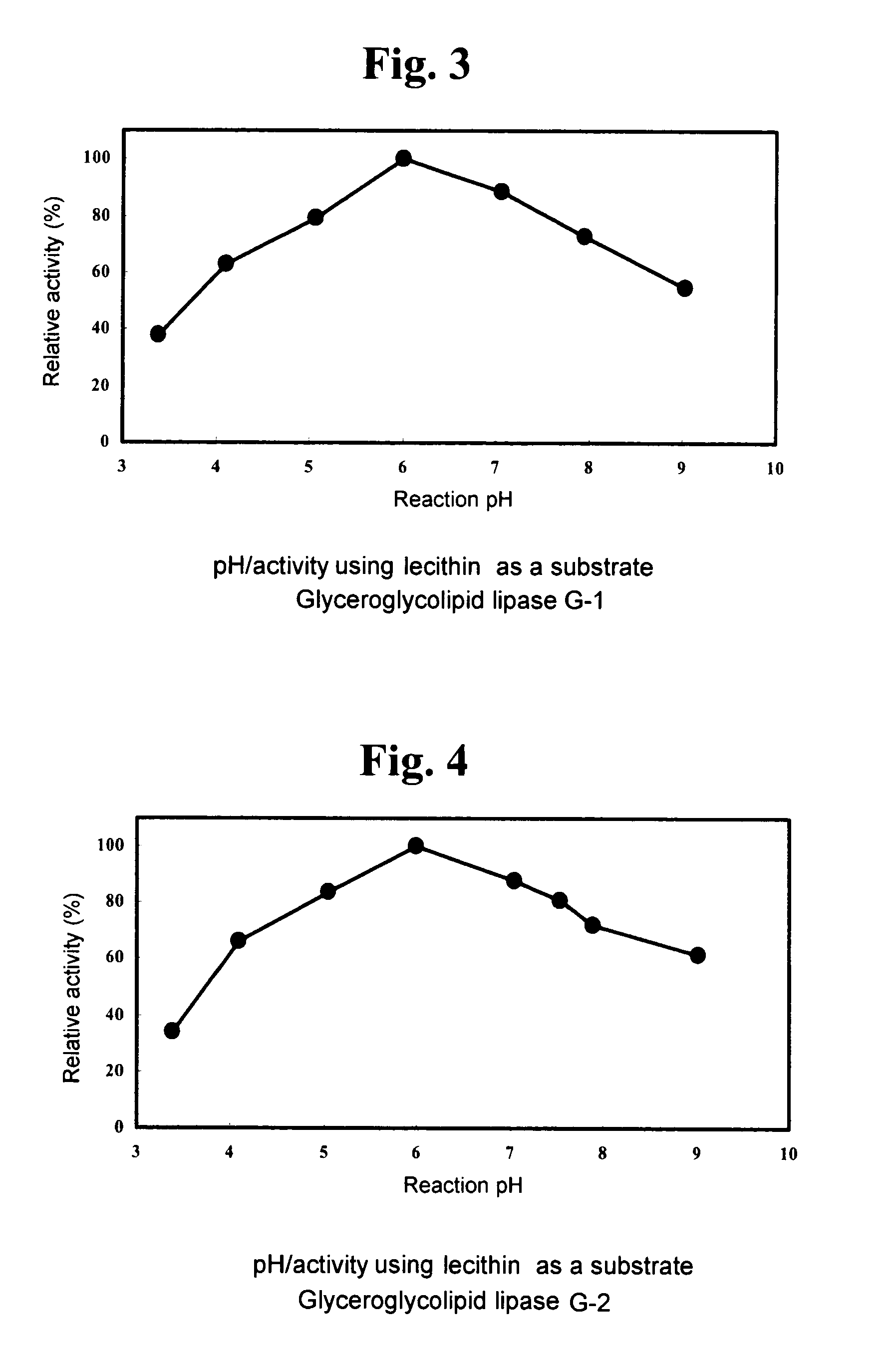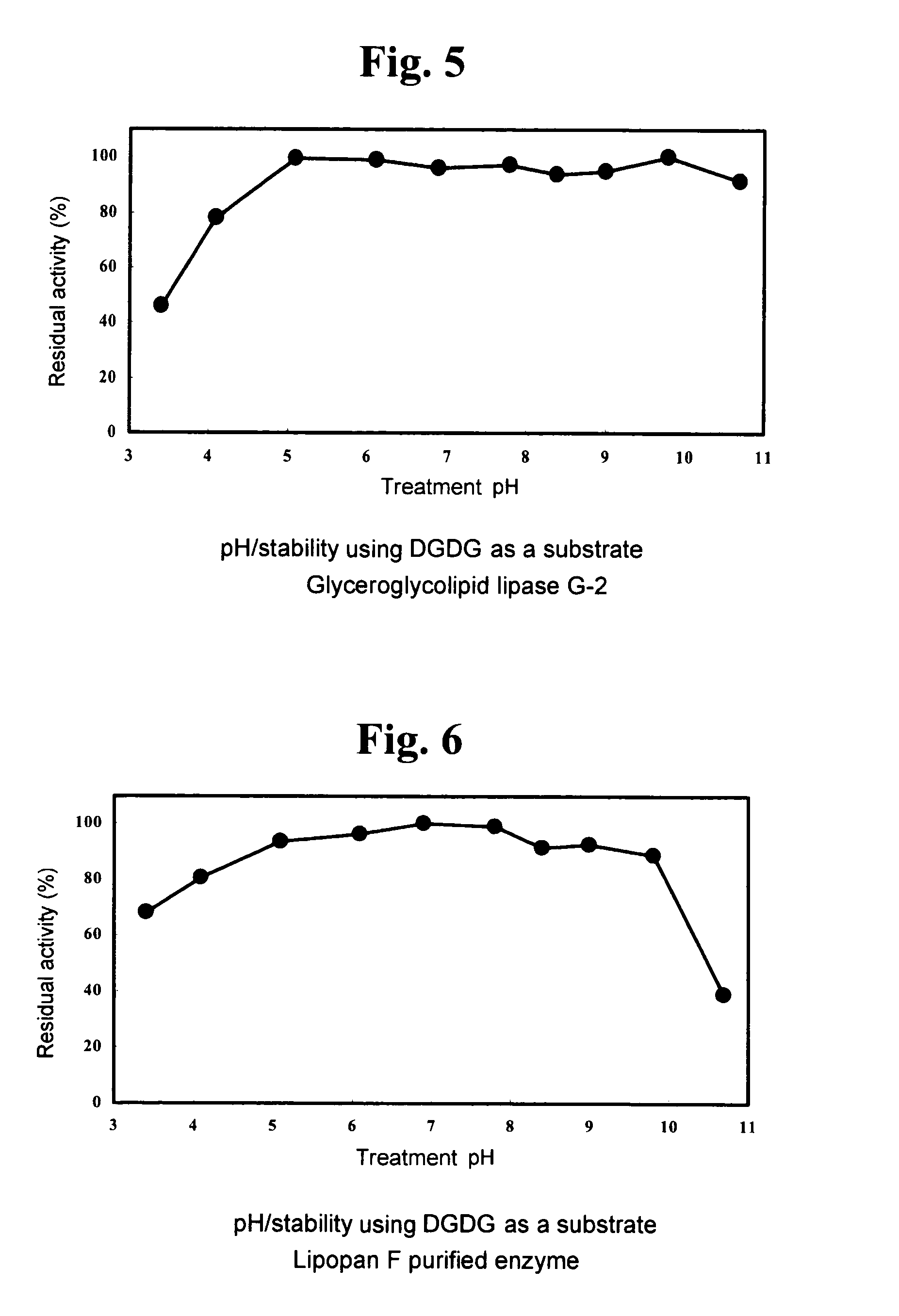DNA encoding glyceroglycolipid lipase
a glyceroglycolipid and lipase technology, applied in the field of glyceroglycolipid lipase, can solve the problems of low hydrolyzeability of neutral fats, particularly triglycerides, and poor performance of lipases derived from plants, and achieve the effect of efficient hydrolysis of glyceroglycolipid
- Summary
- Abstract
- Description
- Claims
- Application Information
AI Technical Summary
Benefits of technology
Problems solved by technology
Method used
Image
Examples
example 1
Purification of Glyceroglycolipid Lipase from Strain SANK 11298
1) Preparation of Crude Enzyme Solution
[0140]Cells of strain SANK 11298 were inoculated into 100 ml of a sterilized medium of the following composition contained in a 500-ml Erlenmeyer flask, and cultured with shaking at 170 rpm at 26° C. for 4 days.
[0141]
Medium compositionGlucose20gYeast extract10gCasamino Acids10gGround sesame20gTween 8010gDipotassium hydrogenphosphate0.1gMagnesium sulfate0.05g
It was adjusted to 1,000 ml with pure water.
[0142]After completing the culture, centrifugation was carried out at 10,000×G and at 4° C. for 10 minutes. The resulting supernatant was used as a crude enzyme solution.
2) Method of Measuring Enzymatic Activity
[0143]The hydrolytic activity of the glyceroglycolipid lipase was measured as follows:
1. Using DGDG as Substrate (DGDG Degradation Activity)
[0144]A fraction extracted and purified from Nisshin Flour weak wheat flour (Nisshin Flour Milling Inc.), which gives a single spot on TLC a...
example 2
Purification of Glyceroglycolipid Lipase from Lipopan F
[0155]1M ammonium sulfate solution was added to Lipopan F (20 g) to elute the enzyme, and the precipitate was then removed. The supernatant was applied and adsorbed to a Toyopearl Butyl 650M (Tosoh Corporation) column (2.2 cm in diameter×20 cm in length) which had been equilibrated with 1M ammonium sulfate. The column was washed extensively with 1M ammonium sulfate. Then, 600 ml of a linear gradient from 1 M ammonium sulfate to 0 M ammonium sulfate with 0.1% TWEEN 80® was prepared to elute the components adsorbed to the column. The lecithin degradation activity was eluted in a fraction (120 ml) at 0 M-0.2 M ammonium sulfate concentration. This fraction was used as a Lipopan F partially purified enzyme fraction.
[0156]120 ml of the obtained active fraction was dialyzed 3 times against 4,000 ml of 10 mM Tris-HCl / 0.1% TWEEN 80® buffer (pH 8) for 12 hours each, and was then applied and adsorbed to a Toyopearl DEAE 650M (Tosoh Corpora...
example 3
Identification of DNA Encoding the Glyceroglycolipid Lipase of Strain SANK 11298
1) Purification of Total RNA
[0159]Strain SANK 11298 was precultured at 26° C. for 2 days in 20 ml of a liquid medium (2% polypeptone (Wako Pure Chemical Industries, Ltd.), 0.5% yeast extract, 0.02% dipotassium hydrogenphosphate, 0.05% magnesium sulfate). The preculture was then inoculated at a ratio of 1% into a liquid medium (2% glucose, 1% yeast extract, 1% Casamino Acids, 2% ground sesame, 1% TWEEN 80®, 0.1% dipotassium hydrogenphosphate, 0.02% magnesium sulfate) and cultured at 26° C. for 4 days. The cultured cells were collected by aspiration and transferred to a mortar (autoclaved) which had been cooled at −80° C. The cells were crushed and powdered using a pestle while adding liquid nitrogen. Total RNA was purified from the completely powdered cells using RNeasy Plant MiniKit (Qiagen GmbH). 50 μl of a solution at a concentration of 660 ng / μg was obtained.
2) Analysis of Glyceroglycolipid Lipase Gen...
PUM
| Property | Measurement | Unit |
|---|---|---|
| pH | aaaaa | aaaaa |
| pH | aaaaa | aaaaa |
| pH | aaaaa | aaaaa |
Abstract
Description
Claims
Application Information
 Login to View More
Login to View More - R&D
- Intellectual Property
- Life Sciences
- Materials
- Tech Scout
- Unparalleled Data Quality
- Higher Quality Content
- 60% Fewer Hallucinations
Browse by: Latest US Patents, China's latest patents, Technical Efficacy Thesaurus, Application Domain, Technology Topic, Popular Technical Reports.
© 2025 PatSnap. All rights reserved.Legal|Privacy policy|Modern Slavery Act Transparency Statement|Sitemap|About US| Contact US: help@patsnap.com



